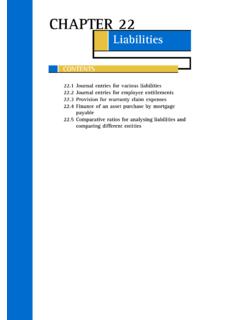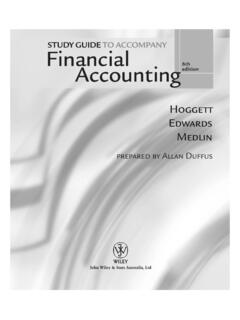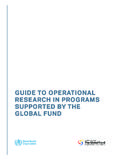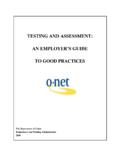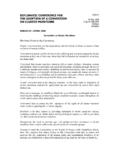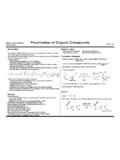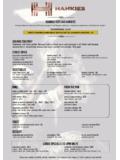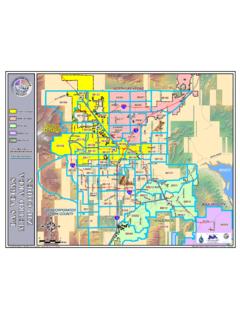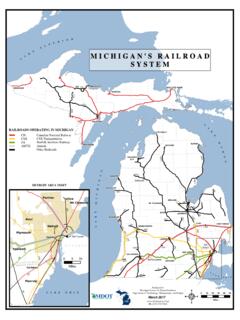Transcription of C h a p te r 8 B u s in e s s C o m b in a tio n s
1 8/26/20081 Chapter 8 Business Combinations Prepared by Emma HolmesWhat is a business combination and what forms do they have?Kerry ClarkExecutive Director Technical Consulting GroupErnst & Young MelbourneThe nature of a business combination AASB 3 defines a business combination as: the bringing together of separate entities or businesses into one reporting entity A business is not just a group of assets, rather, it is an entity able to produce output8/26/20082 The nature of a business combination Three general forms of business combination are as follows (assuming the existence of two companies A Ltd and B Ltd) Ltd acquires all assets and liabilities of B Ltd B Ltd continues as a company, holding shares in A Ltd acquires all assets and liabilities of B Ltd B Ltd Ltd is formed to acquire all assets and liabilities of A Ltd and B LtdA Ltd and B Ltd liquidateRefer to figure of text for key steps involved under each of the above scenariosRefer to figure of text for key steps involved under each of the above scenariosWhen a business is seeking to acquire another, at what stage should accounting advice be sought?
2 Kerry ClarkExecutive Director Technical Consulting GroupErnst & Young MelbourneAccounting for business combinations: Basic principlesAASB 3 prescribes the acquisition method in accounting for a business combination. The key steps in this method an the acquisition and measure the identifiable assets acquired, the liabilities assumed, and any non-controlling interest in the acquiree; and measure goodwill or a gain from bargain for business combinations: Identifying the acquirer The business combination is viewed from the perspective of the acquirer The acquirer is the entity that obtains control of the acquiree In most cases this step is straight forward. In other cases judgement may be required > eg where two existing entities (A&B) combine and a new entity (C) is formed to acquire all the shares of the existing entities Who is the acquirer? Cannot be C Indicative factors contained within Appendix B of AASB 3 to assist in identifying the acquirerWhen acquiring an entity what issues need to be considered, both on and off the balance sheet?
3 Annette KimmittPartner Technical Consulting GroupErnst & Young MelbourneAccounting for business combinations: Determining the acquisition date Acquisition dateis the date that the acquirer obtains control of the acquiree Determining the correct acquisition date is important as the following are affected by the choice of acquisition date: The fair values of net assets acquired Consideration given, where the consideration takes a non-cash form Measurement of the non-controlling interest8/26/20084 Allocating in the records of the acquirer: assets acquired and liabilities assumedFair value allocation occurs at acquisition date and requires the recognition of: Identifiable tangible and intangible assets Liabilities Contingent liabilities Any non-controlling interest in the acquiree GoodwillFVINA = fair value of identifiable net assets (incl. contingent liabilities)Accounting in the records of the acquirer: assets acquired and liabilities assumed: contingent liabilities AASB 3 requires that contingent liabilities which can be measured reliably are recognised by the acquirer The above requirement does not consider issues of probability Therefore contingent liabilities where a present obligation exists but that do not qualify for recognition in the acquiree's books under AASB 137 may be recognised by the acquirer as part of a business combination The fair value of a contingent liability is the amount that a third party would charge to assume those contingent liabilities.
4 Such an amount reflects the expectations about possible cash flows. This is not simply the expected maximum/minimum cash flowAccounting in the records of the acquirer: intangible assets AASB 3 requires the acquirer to recognise intangible assets where their fair value can be measured reliably Figure contains a list of intangibles that the AASB consider would meet the definition of an intangible for the purposes of accounting for a business combination The fair value of an intangible reflects market expectations about the probability of future economic benefits flowing to the entity Eg > if the expected benefits are $1,000 and the probability of receiving the benefits is 90%, the fair value will be $900 Examples include trademarks, customer lists, royalty agreements, patented technology include trademarks, customer lists, royalty agreements, patented technology in the records of the acquirer.
5 Measurement AASB 3 requires that assets acquired and liabilities and contingent liabilities assumed are measured at fair value Fair value is basically market value Fair value is determined by judgement, estimation and a three-level fair value hierarchy Fair value reference to observable prices of market transactions for identical assets or adjusting observable prices of market transactions for similar assets or using other valuation techniques Note the similarities between these requirements and those of AASB 138, relating to intangible similar asset or liability is one that is reasonably comparable. Eg a similar asset may be identical in all respects except for location A similar asset or liability is one that is reasonably comparable. Eg a similar asset may be identical in all respects except for location Where such techniques are adopted, the used market inputs should be maximised and the used internal estimates minimisedWhere such techniques are adopted, the used market inputs should be maximised and the used internal estimates minimisedAccounting in the records of the acquirer: measurementAccounting in the records of the acquirer: consideration transferredThe acquirer measures the consideration transferred as the fair values at the date of acquisition of Assets given Liabilities (including contingent liabilities) assumed Equity instruments8/26/20086A business combination involves the consideration and measure of fair value of the acquiree, how can this be accurately measured?
6 Annette KimmittPartner Technical Consulting GroupErnst & Young Melbourne The consideration paid by the acquirer may consist of one or a number of the following forms of consideration: Cash Non-monetary assets Equity instruments Liabilities undertaken Cost of issuing debt/equity instruments ContingenciesAccounting in the records of the acquirer: consideration transferred Cash Where the settlement is deferred, the cash must be discounted to present value as at the date of acquisition The discount rate used is the entity s incremental borrowing rateEquity instruments Where an acquirer issues their own shares as consideration they need to determine the fair value of the shares as at the date of exchange If listed, the fair value is the quoted market price of the shares (with a few limited exceptions)Accounting in the records of the acquirer: consideration transferred 8/26/20087 Costs of issuing debt and equity instruments Transaction costs such as stamp duties, underwriting fees and brokers fees may be incurred in issuing equity instruments Such costs are considered to be an integral part of the equity transaction and should be recognised directly in equity Journal entry required would be:Dr Share Capital xxCrCash xx Costs associated with the issue of debt instruments are included in the measurement of the liabilityAccounting in the records of the acquirer.
7 Consideration transferred Contingencies In some cases the agreement will provide for an adjustment to the cost of the combination contingent on a future event Example -where an acquirer issues shares as part of their consideration, the agreement may require an additional payment of the value of the shares falls below a certain amount within a specified period of time If the adjustment is probable and can be measured reliably, then the amount should be included in the calculation of the cost of acquisitionAccounting in the records of the acquirer: consideration transferred Acquisition related costs that are directly attributable to a business combination not form part of the consideration transferred, rather they are expensed as incurred. Accounting in the records of the acquirer: consideration transferred 8/26/20088 Calculating consideration transferred: exampleOn 1 January 2009 A Ltd acquired all the assets and liabilities of B Ltd.
8 Details of the consideration transferred are as follows: Cash of $400,000, half to be paid on 1 January 2009, with the balance due on 1 January 2010. The incremental borrowing rate for A Ltd is 10% 100,000 shares in A Ltd were issued. The share price on 1 January 2009 was $ per share. This price represented a six-month high. Costs of issuing the shares was $1,000. Due to doubts as to whether the share price would remain at or above the $ level, A Ltd agreed to supply cash to the value of any decrease in the share price below $ This guarantee was valid for a period of 3 months (to 31 March 2009). A Ltd believed that there was a 75% chance that the share price would remain at or above $ until 31 March 2009 (and a 25% chance that it would fall to $ ) Supply of a patent to B Ltd. The FV of the patent is $60,000. As the patent was internally generated it has not been recognised in A Ltd s books.
9 Legal fees and associated with the acquisition totalled $5,000. Required:Calculate the consideration transferredCashPayable now200,000 Deferred ($200,000 x )181,818 Shares100,000 x $ ,000 Guarantee100,000 x ($ $ ) x 25%2,500 Patent60,000 Total cost of acquisition594,318 Discounted to PV at rate of 10%Discounted to PV at rate of 10%Based on quoted market priceBased on quoted market priceBased on probability of share price falling below $ on probability of share price falling below $ of patentFV of patentNote that share issue costs, legal fees and stamp duty are excluded from the calculationNote that share issue costs, legal fees and stamp duty are excluded from the calculationCalculating consideration transferred: exampleAccounting in the records of the acquirer: Goodwill When a business combination results in goodwill, AASB 3 requires that the goodwill is: recognised as an asset initially measured at its cost at the date of acquisition Goodwill = consideration transferred - acquirer s interest in the FVINA Goodwill is considered to be a residual interest Goodwill is an unidentifiable asset which is incapable of being individually identified and separately recognised8/26/20089 ExampleDetails of B Ltd s assets and liabilities acquired by A Ltd are as follows:CAFVP lant & equipment360,000367,000 Land170,000175,000 Motor vehicles90,00082,000 Inventory24,00030,000 Accounts receivable18,00016,000 Accounts payable(35,000)(35,000)Bank overdraft(55,000)(55,000)Net assets572,000580,000B Ltd is currently being sued by a previous customer.
10 The expected damages is $50,000. Lawyers estimate that there is a 20% chance of losing the case. Accounting in the records of the acquirer: Goodwill Required:a)Calculate the FVINA acquired and determine the amount of goodwill on )Prepare the journal entry in the books of A Ltd to account for the acquisitionFair value of recorded net assets580,000 Less: Contingent liability re damages ($50,000 x 20%)(10,000)FVINA570,000 Cost of acquisition594,318 Goodwill on acquisition24,318 Carrying amounts in B s books are irrelevant to ACarrying amounts in B s books are irrelevant to ABased on probability of losing the caseBased on probability of losing the casePer Slide 23 Per Slide 23 Residual interest Residual interestAccounting in the records of the acquirer: Goodwill Journal entry in the books of A Ltd to accounts for the acquisitionDrPlant & equipmentDrLandDrMotor vehiclesDrInventoryDrAccounts receivableDrLegal fee expenses5,000 CrAccounts payableCrBank overdraft367,000175,00082,00030,00016,00 0Dr Goodwill24,31835,00055,000 CrProvision for damages10,000 CrCash206,000 CrDeferred consideration payable181,818 CrShare capital149,000 CrProv for loss in value of shares2,500 CrGain on sale of patent60,000 FVFVR esidual interestResidual interestFVFVC ontingent liabilityContingent liabilityComponents of cost of acq nComponents of cost of acq n200,000 cash paid - 5,000 legal fees - 1,000 share issue costs200,000 cash paid - 5,000 legal fees - 1,000 share issue costs150,000 FV of shares issued - 1000 Share issue costs150,000 FV of shares issued - 1000 Share issue costsAccounting in the records of the acquirer.
